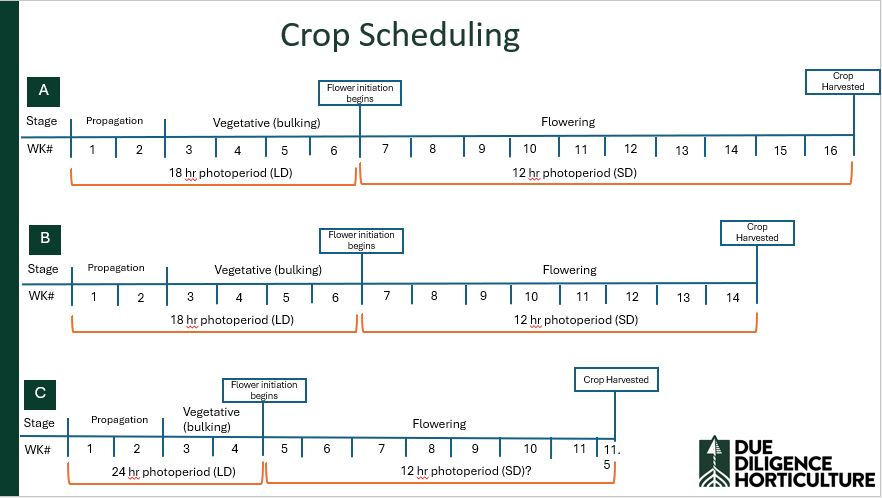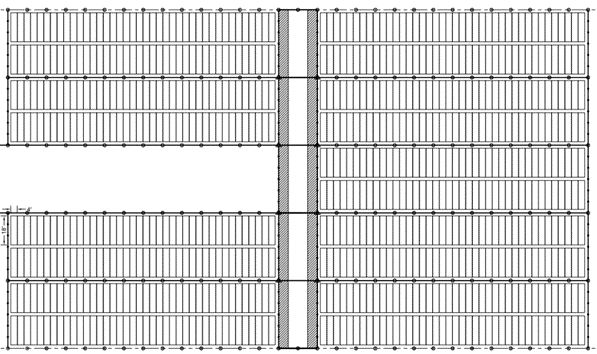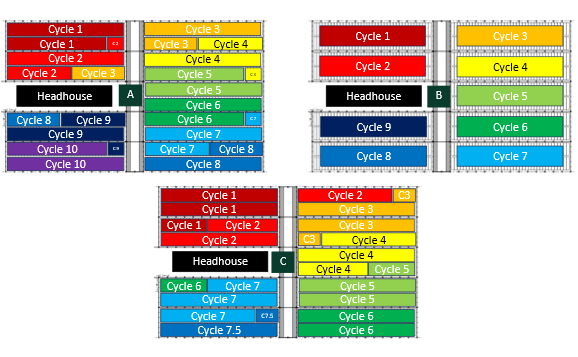
Wherever you’re at, geographically or operationally, your square foot utilization strategy (square foot turn rate/year) is critical to your success. You may be flying high in Missouri, expanding and breaking ground on a new production facility, fetching $3,100 per pound for indoor flower, or you’re bracing for impact in Michigan due to the vast expansion of hundreds of acres of outdoor production. Maybe you’re in California, laser-focused on hype genetics, color, variety, price point and costs—and hoping for a bulk price close to $600 to $700 per pound for greenhouse flower. A solid, efficient utilization strategy of your production area is crucial to position your business for success in any market.
As existing and new markets become bloodier (which they will) with competition, fighting without an efficient, effective square foot utilization strategy ultimately will limit or kill your chances for a competitive edge. When the game is on, it can be life or death.
It’s time to ask: What steps can you take to guarantee you are at par or ahead of the competition in relation to how aggressively you turn your facility annually? What foundational horticultural strategies have you overlooked that could give you the edge you need to outmaneuver the competition and maximize your production footprint in this high-stakes game?
Your square foot utilization efficiency sets the stage for every other aspect of your production in cannabis cultivation. Before resource efficiency, process efficiency or labor use efficiency can be adequately considered and planned, optimizing your square foot utilization efficiency must come first. An efficient, optimized crop production schedule should take priority and inform every step you make (process, technology and required headcount), operationally. Even more importantly, it informs your projected budget, and annual yield and revenue forecasts, informing you how soon you can reach your target: positive cash flow.
Understanding Square Foot Utilization Efficiency
So, what is square foot utilization efficiency (SFUE) and how do you achieve it? A grower’s primary responsibility is to optimize the use of their fixed and limited production footprint (the asset) strategically and effectively within a given amount of time. As one of the four pillars of horticultural production success (area, time, energy and yield), your production area is the foundation of your entire business model, regardless of whether your production system is indoor, greenhouse or outdoor. This principle even extends to manufacturing and management of the retail shelf.
The following examples convey the meaning of SFUE and reveal the opportunities that lie within this area pillar. They also connect it to the second pillar of horticultural production success, time, to fully take advantage of these foundational principles.
Please note that the strategies discussed here are simplified for the sake of discussion in this article and could be much more complex regarding plant count, timing, photoperiod manipulation to speed up cycle time, fertilizer and plant nutrition to influence flower timing, and other factors unique to individual growing operations and commercial horticultural experts.
Figure 1 below walks through three production schedules—A, B and C—that directly indicate a grower’s square foot utilization efficiency. As you can see, these range from 16 weeks to 11.5 weeks.


Understanding the importance of a weekly perpetual harvest schedule is key to understanding the strengths and weaknesses in these three schedules, where every turn in effect increases your annual accumulated square foot harvested. In other words, the shorter the cycle and the more turns per square foot per year, the higher your total grams per square foot harvested per year. So, let’s break this down.
Below is a sample Greenhouse Flowering Design with the following design specs, as shown in Figure 2:
- 51,840 sq. ft. total bench/canopy area
- 80 benches per bay
- Each bench 72 sq. ft.
- 9 separate bays
- All automated movable benches


Understanding the benefits of a weekly perpetual schedule should be clear before diving into the benefits and differences of these three schedules. In this example, this greenhouse is scheduled to harvest weekly for each of the different flower cycle times as there is no excuse why you should not harvest at least every week. Some growers are harvesting daily, turning even more aggressively, but this can be tricky and risky.
A weekly perpetual schedule puts everything from your production stages, steps and processes on a weekly schedule. From taking cuttings, to transplanting, to pinching/topping, to moving plants to veg and flower, to skirting, defoliating, harvesting, turnaround, drying, bucking, trimming, packaging into inventory and distribution for sales. When you’re able to manage this schedule, you enable your cultivation production system to have the same tasks per production stage, per step, per week, per employee. That has huge implications for labor, product quality consistency and product volume predictability for sales.
Consistency in labor planning is key to success in any industry, but especially in cannabis cultivation because of the limited amount of automation deployed due to the lack of factors such as scale, large-scale seed adoption and overall consistent, uniform and predictable genetics. The industry is close but not there yet, and some at scale could do it better and lead the way, in my opinion.
Most systems have a 1:1 relationship with labor cost to plant count. So, managing tasks tied to plant count per week provides the ideal opportunity to focus on performance management, implement incentive programs to increase throughput, and track performance based on seasonal changes in both weather and pricing to optimize margin consistency and optimization throughout the year.
Now we can appreciate the whole production system being on a weekly schedule—and doing our best to have each cycle every week be of the same size, to offer consistent and predictable product-to-sales while keeping costs fixed.
Next, let’s dive into the total amount of area we cover, annually—and therefore the total amount of product we can actually produce/accumulate per square foot per year with these different schedules.
Not taking veg time and area required into account, these three schedules require 10 week, 9 week and 7.5 week flower times. (More to come on this in a later column, as flowering optimization makes the point even more clear as it is directly tied to revenue. However, veg space in relation to this flowering strategy is just as much of a puzzle and needs the same level of scrutiny, especially if the ratio of nursery to flowering square footage is off from the start.)
We can start our labor planning based on a headcount per square foot and then plant count. If we were to choose this headcount based on total square feet, this means that we could possibly manage the same headcount for all three production scenarios, assuming they have the same crop density—thus revealing obvious benefits of whichever scenario yields the highest from a labor cost/pound and revenue perspective.
The differences become clear when focusing only on annual yield and square footage, tied to a revenue of $650 per pound bulk pricing sold and an average yield of 42 grams of flower per square foot per cycle or week, as shown below. In this example, Square Foot Utilization Efficiency can result in a nearly $3.25 million difference in total bulk revenue, annually:
Schedule A
- Annual sq. ft. harvested per year: 270,000
- Total grams flower/ft2/year: 218
- Total flower pounds per year: 25,000
- Total bulk revenue: $16.25m
Schedule B
- Annual sq. ft. harvested per year: 300,000
- Total grams flower/ft2/year: 240
- Total flower pounds per year: 28,000
- Total bulk revenue: $18.2m
Schedule C
- Annual sq. ft. harvested per year: 360,000
- Total grams flower/ft2/year: 290
- Total flower pounds per year: 30,000
- Total bulk revenue: $19.5m
So, for those in the cannabis cultivation industry, refining square foot utilization efficiency is not merely an operational choice but a strategic imperative. By optimizing every square foot of production space, cultivators can reduce their cost/lb. via enhanced yields, streamline operations, and increase profitability. As the cannabis market evolves, those who master this efficiency will not only survive but thrive, staying ahead of the competition and leading the industry into the future.
Author’s note: Calling Cannabis Breeders! Who will provide the market with a 5.5- to 6-week harvest flowering time? If it is possible, I would invest heavily in the R&D to make it happen knowing how impactful flowering time can impact cultivators’ business profitability.
Travis Higginbotham is the founder of Due Diligence Horticulture (DDH) and an authority in commercial horticulture and cannabis production. He holds a B.S. in Horticulture from Clemson University and an M.S. in Horticulture from Virginia Tech. Most recently, he served as vice president of cultivation at California's Statehouse Holdings managing a Cultivation Business Unit responsible for over 223,000 square feet of canopy, postharvest, processing, distribution and bulk sales. Prior to Statehouse, Higginbotham was director of research and development at Battlefield Farms, managing global partnerships with major retailers and plant breeders focused on production research and product development for a 1.8-million-square-foot greenhouse operation. After Battlefield, he was global director of Horticulture Services at Fluence Bioengineering, where he co-invented two smart farming patents and led a global technical support team. He also served as vice president of sales and business development at The Hemp Mine, establishing a robust supply chain for cannabis genetics in the hemp sector. Currently, he leads DDH, taking on fractional CEO roles in multiple states, spinning up operations of distressed assets, and serves in advisory and board positions for several companies, driving advancements in horticultural practices and cannabis production.
Latest from Cannabis Business Times
- Navigating Cultivation Room Design: Optimization vs. Maximization
- Verano Opens 18th Medical Cannabis Dispensary in Pennsylvania
- Hundreds Interested in Kentucky’s Medical Cannabis Licenses; Just 17 Apply So Far
- Aurora Receives Expanded Cultivation, Unique Research Licenses for German Facility
- Curaleaf Opening 2 New York Medical Dispensaries, Launching Adult-Use Sales at 2 Other Stores
- Ohio’s Adult-Use Licensing Process Leads CBT’s Top Stories in July
- Planet 13 Launches Lifestyles Brand Company; Signs 1st Sponsored Athlete in UFC Title Contender Chito Vera
- LeafLink Acquires Leading Cannabis Banking Platform Dama Financial





